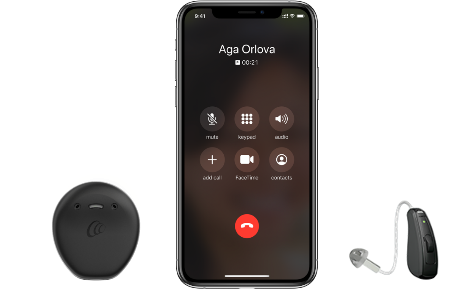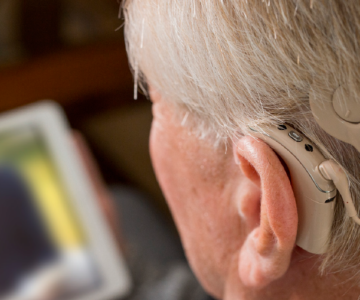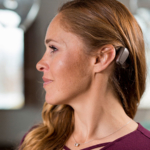By Natasha McDougald, Product Manager: Sound Processors, Bimodal and Connectivity
The Smart Hearing Alliance
Ears work as a team and there are advantages to hearing well with both ears. For some people with a cochlear implant, having a ReSound hearing aid on the other ear provides the best possible hearing through a bimodal solution. Bimodal hearing in general may improve speech recognition in noise, including locating where sounds are coming from, while also providing superior sound quality compared with using a cochlear implant alone.1-4

The Smart Hearing Alliance, a unique collaboration between Cochlear and ReSound, makes it easy to provide a bimodal solution for your patients. The partnership provides connectivity solutions that work with both the ReSound hearing aid and the cochlear implant. ReSound and Cochlear share wireless technology, so your clients can stream directly to their cochlear implant and hearing aid simultaneously from compatible iOS or Android™ devices, or from a range of wireless accessories with no need for intermediary devices. With more sound to both ears and superior sound quality compared to using a cochlear implant alone4, recipients can take phone calls, enjoy music, TV or ZOOM chat with a friend in a busy chattering home environment.
The Cochlear™ Nucleus® Kanso® 2 Sound Processor
Cochlear has expanded its sound processor portfolio through a series of approvals such as the Kanso 2 Sound Processor, allowing clinicians to fit either an off-the-ear or traditional-behind-the-ear sound processor without compromising performance-enhancing algorithms or direct connectivity to smartphones. The innovative Kanso 2 Sound Processor introduces a built-in rechargeable battery designed for all-day hearing~, paired with the highest dust and water resistance for a cochlear implant sound processor for added peace of mind for your patients.+
The ReSound ONE™ hearing aid
On August 18, 2020, GN Hearing globally unveiled ReSound ONE™ hearing aid, a new hearing aid* that solves one of the most enduring challenges for people with hearing loss. For the first time, this unique solution places an additional microphone inside the ear canal, allowing people relying on hearing aids to experience the world with their own ears while preserving the comfort of an RIE device.* Now every patient may enjoy the benefit of superior sound quality and hear conversations better in noisy environments. At launch, ReSound ONE will be bimodally compatible with the True Wireless™ accessories. Linking capabilities for direct bimodal streaming from compatible Apple and Android devices, are expected to be available with a service release of Custom Sound Pro later this year.
Complementary innovation to improve the patient experience
Cochlear and ReSound have been collaborating on technology development, product solutions, design and engineering capabilities since 2011, and these new hearing devices benefit from this complementary approach.
Bimodal built-in rechargeability: For the first time, bimodal patients can experience the convenience and simplicity of a cochlear implant sound processor and hearing aid with integrated rechargeable batteries.
User-activated algorithms for challenging environments: Patients wearing the Kanso 2 Sound Processor and ReSound ONE hearing aid will have the control to focus on sounds in front of them, using two pre-processing strategies: ForwardFocus^ from Cochlear and a clinician-programmed narrow beam vis Adaptive Directionality from GN Hearing. These enhanced operating modes are designed to improve speech recognition, giving patients the control to increase hearing focus.
Automatic setting adjustment: Noise Tracker II, Environmental Optimizer II and Soft Switching from GN Hearing uniquely complements Cochlear’s Smart Sound IQ with SCAN#, allowing the hearing devices to automatically adjust settings and microphone directionality to improve the listening experience.
Quality care from anywhere: The impact of the COVID-19 global pandemic has irrevocably changed the healthcare landscape and has necessitated a change in how hearing healthcare services are provisioned. The Smart Hearing Alliance has addressed these challenges through the development of hearing devices that include built-in connectivity for remote care delivery.
For example, GN Hearing pioneered the remote hearing care vision, by introducing ReSound Assist in 2017. ReSound Assist allows varying levels of care, including Live Assistance for face-to-face video appointments, incorporating real-time feedback from patients, or Remote Fine-Tuning for sending adjustments anytime. Cochlear has the only FDA approval for remote programming. It also received expedited approval in April 2020 for Remote Check, a convenient, at-home testing tool that allows patients to complete a hearing review with a Kanso 2 or Nucleus 7 Sound Processor using an iPhone® or iPod touch® without having to travel to the clinic.**
Clinicians fitting Smart Hearing Alliance solutions are positioned to deliver an enhanced bimodal experience with proven hearing satisfaction, facilitating care today and in the future. 5
To learn more visit ReSound or watch this webinar on Cochlear’s latest innovations.
About the author: Graduating in Management Information Systems, Natasha McDougald began her career as a system analyst working with tech companies in the Silicon Valley. Personal circumstances became a catalyst for career change; transitioning from desktop-based computers to tiny embedded biomedical computers known as cochlear implants. Natasha has worked at Cochlear Americas for over 9 years partnering with clinicians and surgeons at the University of Miami, UCSF, Stanford, UC Davis and UCSF Benioff Children’s Hospital of Oakland to bring cochlear implants to pediatric and adult patients. Extremely passionate, Natasha is professionally and personally invested in the implantable hearing industry and strives to forward the cause of those affected by hearing loss. She has presented numerous talks and courses on hearing loss, multiple disabilities, advocating skills and cochlear implantation to audiences in the medical-technology, educational, special needs and family support sectors.
+ The Kanso 2 Sound Processor is dust and water resistant to level of IP68 of the International Standard IEC60529. The Kanso 2 Sound Processor with Aqua+ is dust and water resistant to level of IP68 of the International Standard IEC60529. This water protection rating means that the sound processor with the Aqua+ can be continuously submerged under water to a depth of up to 3 meters (9 feet and 9 inches) for up to 2 hours. The Aqua+ accessory should be used when participating in prolonged water activities.
* Microphone in ear and two standard directional microphones, directionality features, wireless audio streaming.
^ForwardFocus can only be enabled by a hearing implant specialist. It should only be activated for users 12 years and older who are able to reliably provide feedback on sound quality and understand how to use the feature when moving to different or changing environments. It may be possible to have decreased speech understanding when using ForwardFocus in a quiet environment.
#It is recommended that SNR-NR, WNR and SCAN be made available to any recipient, ages 6 and older, who is able to 1) complete objective speech perception testing in quiet and noise in order to demonstrate and document performance and 2) report a preference for different program settings.
**The Remote Check feature of the Nucleus Smart App is available on iPhone and iPod touch. For compatibility information visit www.cochlear.com/compatibility.
~All day hearing is defined as 16 hours, expected battery life is up to 18 hours. Battery life may vary by individual.
For compatibility information and devices visit www.Cochlear.com/compatibility and resound.com/compatibility
For a list of compatible ReSound hearing aids visit www.Cochlear.com/nucleus/compatibility
References
1. Ching TY, Incerti P, Hill M. Binaural benefits for adults who use hearing aids and cochlear implants in opposite ears. Ear Hear (2004 Feb); 25, 9–21.
2. Morera C, Cavalle L, Manrique M, et al. Contralateral hearing aid use in cochlear implanted patients: Multicenter study of bimodal benefit. Acta Otolaryngol (2012 Jun); 132, 1084–1094.
3. Potts LG, Skinner MW, Litovsky RA., et al. Recognition and localization of speech by adult cochlear implant recipients wearing a digital hearing aid in the nonimplanted ear (bimodal hearing). J Am Acad Audiol (2009 Jun); 20, 353–373.
4. Farinetti A, Roman S, Mancini J, et al. Quality of life in bimodal hearing users (unilateral cochlear implants and contralateral hearing aids). Eur Arch Otorhinolaryngol (2015 Nov); 272, 3209–3215
5. Clinical Evaluation of the Cochlear Nucleus CI532 Cochlear Implants in Adults Investigator Meeting. 2019 Apr.









